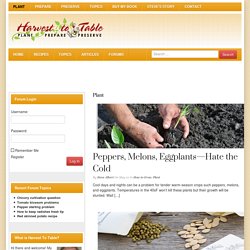

Community Garden. CFSA Conference. Seed information. Chickens. Organic vs Not. Solar power. Fantastic Farm Garden Calculator. Search results. DIY Build or Hack. When is the best time to plug logs, and other nitty-gritty on mushroom log cultivation - Everything Mushrooms. Posted by Cathy S. on November 18, 2015 The best time of the year to plug logs, at least here in East Tennessee, is February and March because of the weather and the sap run.

Logs we have plugged this time of year have produced mushrooms in 4-5 months. However we have had success plugging logs all year just as long as logs are recently cut (within the month) from a disease free tree. With careful management, each log should produce around 2 pounds of mushrooms over its lifetime, but uncontrollable factors such as wind, temperature and humidity will effect yields.
Expect mushrooms within one year, total productive life of log can be 4-6 years. Weather: February and March typical average temperatures of 50°F will support mycelium growth while keeping in check the growth of other organisms. Sap: In the fall, life essential juices are sucked from the leaves and shipped to the roots for winter storage. Build Your Own Walk In Cooler with a CoolBot Controller and A/C Unit.
Root Cellars 101- Root Cellar Design, Use and Mistakes to Avoid. Eartheasy Blog » How to Establish a Clover Lawn. Ah, the backyard lawn, that controversial patch of greenery adored by some and shunned by others.

Restricted to the aristocracy before mechanical mowers made them possible for humbler folk, lawns have become the norm of boulevards and subdivisions alike. But how ‘green’ are they? On the one hand, lawns require large amounts of water to survive. They are monoculture crops that provide minimal benefits to nature. On the other hand, lawns are ground covers that can prevent the encroachment of unwanted or invasive weeds. The Farmer's Dog: Homemade dog food, DIY or delivered. Successful cold storage. Crisp carrot sticks, fresh cabbage, and fried potatoes from my Montana garden in June?

Yes, but only if I’ve kept them in cold storage from last summer’s garden. A garden is a wise investment and provides the freshest, most nutritious vegetables available during the summer. But I need it to supply vegetables year-round, and that can be a challenge here in northwest Montana. I lean toward self-sufficiency and eating a local, seasonal, sustainable diet; we try to grow what we eat and eat what we grow.
We preserve, dehydrate, and freeze both fruits and vegetables, making a trip to the fruit room or freezer a real delight throughout the winter. Ideally, I would have a root cellar which maintained the correct temperature for the produce I would like to keep. A storage method is only the last step to having successful cold storage and fresh vegetables in the winter. The Pallet House by I-Beam Design Costs Only $75 and Uses Spare Wooden Pallets. 101+ Meals in a Jar Recipes. Meals in Jar are a great way to put aside whole meals for your food storage.

Through the canning or dry vacuuming process, you can put a meal up to help create long-term food storage. Growing Vegetables in Straw Bales, Straw-Bale Gardening. By Craig LeHoullier CONSIDER the humble bale of straw.

Think beyond its reputation as a Halloween decoration and picture it as a productive part of your garden. The concept is simple: As the straw begins to break down, it turns into a rich, compostable planter that's ideal for growing vegetables. Although the practice of gardening in straw bales dates back to ancient times, I learned of it only a decade ago during a chance encounter with a local straw-bale guru, Kent Rogers. When my publisher asked me to write about straw-bale gardening, I tested the techniques in my own gardens and was quite impressed with the results. Benefits of bales. How to build My 50 Dollar Greenhouse. Straw Bale Gardens. Homestead Notes - Creating a lifestyle of self-sufficiency, sustenance, and survival. Plant Archives - Harvest to Table. Cool days and nights can be a problem for tender warm-season crops such peppers, melons, and eggplants.

Temperatures in the 40sF won’t kill these plants but their growth will be stunted. Wait […] Establishing a seed planting calendar is one of the oldest and wisest gardening maxims. The success of many vegetable and flower sowings is getting the seed started at the right time of […] Many useful culinary herbs grow well in containers.
Planning and planting for fall and winter harvest should begin in early- to mid-summer depending on how soon cold weather will arrive in your region. Vertical garden supports and frames can save a tremendous amount of ground space in the vegetable garden. The Demo Garden Blog. Are you just getting started with vegetable gardening and looking for some ideas on how to plan your garden?

A couple other horticulture agents and I have put together some simple garden plans that will get you started on your garden. These garden plans are all 4 ft x 8 ft gardens, ideally designed to be raised beds. However, raised beds aren’t necessary! If your garden space is bigger, you can simply use several of the garden templates end to end. (If you stack them side by side, you won’t be able to reach the middle!) Diy Natural – Do It Yourself… Naturally. Homemade Cleaner and More. How to make a Worm Tower. Alexe drills holes in a pipe to make a worm tower A worm tower is a simple and effective way to take any garden bed from average yield to gloriously abundant.

Simple to build, with materials you probably already have, a worm tower is the perfect addition to any garden bed, in any climate. It will bring increased fertility to your plants, improve your soil, make every living thing very happy and process organic waste to boot. Planning Succession Crops. Succession planting will allow you to plant several times throughout the growing season for a continuous supply of fresh vegetables.

To plan succession crops you must know two things: • The number of weeks of growing season in your garden. The length of the growing season is the number weeks between the last frost in spring and the first frost in autumn. The local cooperative extension office can tell you the length of the growing season in your location or you can ask an experienced gardener at a nearby garden center. • The number of weeks each crop you wish to grow requires to germinate, grow, and reach harvestable size.